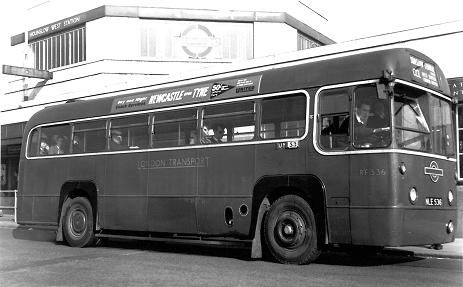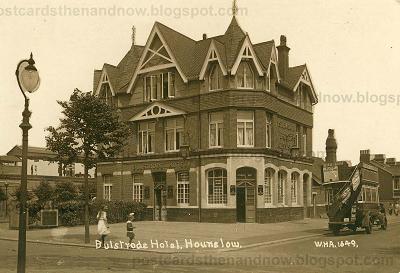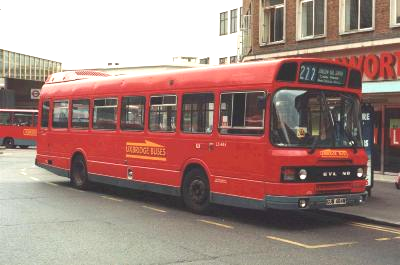 Red RF routes Red RF routes
Route 222
Page last updated 30 July 2016
One of the early Uxbridge
RFs, RF536 pauses at Hounslow West Station on its way to Hounslow
Central on 5 Mar 61, a few weeks before the route was
withdrawn.
Photo © Gerald Mead
Uxbridge's first RF route, one of the 'next wave' of
conversions in 1958 that used RFs made available by the
double-decking of Sidcup's RF routes; the 222 was itself
double-decked two years later.
Dates of RF operation
26 Nov 58 to 14 Mar 61
(total 2 years 4 months, all crew operation).
Destinations
HOUNSLOW CENTRAL and UXBRIDGE STATION
 Reason for single-deck operation Reason for single-deck operationLow rail bridges at Yiewsley and West Drayton restricted
the 222 and 224 to single-deck. In
1961, the road under the West Drayton bridge was lowered, allowing
the double-deck 223 to be extended south in replacement for the
222.
Post-war 14T12 T750 lays over at the Queens
Road stand at Hounslow Central. Thanks to Keith Williams and
his researchers (especially Colin Harris of the Southall Message
Board "Knowhere Guide") for discovering the location.
Photo © PM Photography
Route history
As the General spread its wings after the
First World War, it first reached Uxbridge with the
introduction of route 93 from Hounslow Garage in July 1921.
This was one of the development routes which used the
26-seat type-7 Bs that had proved too heavy for the 111, and ran through rural west Middlesex at a
frequency of every 65 minutes.
In keeping with the General's policy
of using partners to develop services on its periphery, Thames
Valley took over the Uxbridge area routes on the opening of
Uxbridge garage in June 1922. The route was renumbered W20 in
the western country-area series area, running between Hounslow
Bulstrode Hotel and Uxbridge New Inn (the
New Inn was by St Margaret's Church, at the centre of town).
As it entered the Metropolitan Police area, the route required to
be renumbered (again) on introduction of the Bassom system, and became the 501 in
December 1924. Unlike the National and East Surrey
partnerships, the Thames Valley one was not a success, and the
General terminated it from January 1929, taking back operation of
Uxbridge garage and the 501, on which it placed S-class
single-deckers.

The B-type parked in Queens
Road, Hounslow, outside the Bulstrode Hotel in 1913 is opposite the
location of, and facing in the opposite direction to, the TD.
It is working route 82, in the version that operated only in
1913-14 from here to Staines, a route that emerged from the first
world war as the 117 and still runs to Staines. In 1913, the
terminus was known by the then name of the station,
Heston-Hounslow. The station (now Hounslow Central) and the
hotel are still there.
Photo thanks to
www.postcardsthenandnow.blogspot.co.uk.
New 1T1s were allocated temporarily in 1932
and permanently in 1934, at the end of which year the route was
renumbered for a final time, to 222. At that time, the
other Uxbridge single-deck routes (220,
223 and 224)
were all one-man operated. On the 222, Uxbridge garage's
allocation was augmented on Saturdays (when it was half-hourly
rather than hourly) by Hounslow garage up to 1936.
The Uxbridge terminus changed to Market House in 1936 and the
Underground Station (the turning circle in the High Street outside
the new station) in 1940.
The 222 was upgraded to the post-war 14T12s in 1946 using buses
replaced by TDs at Muswell Hill, augmented by prewar 11T11s.
The 14T12s, together with those on the 224 group at Uxbridge
and those on the 211 at Southall, were to
be the last in service in London. On conversion of the 222 to
RF, the 224 group changed over to TD and the last batch of 14T12s
was sold to Ceylon.
Reflecting the development of the area, the Monday to Friday
allocation increased from 2 Ts in 1940 to 5 by 1946, to 6 in 1952
on the introduction of additional peak hour shorts between Uxbridge
and London Airport (i.e. Heathrow North) and to 9 by 1958.
Larger capacity buses were needed.
 Much later, the 222 after
privatisation in 1994. Former Red Arrow National 2 LS484
of Uxbridge Buses is about to depart Uxbridge Bus Station for
Hounslow. Much later, the 222 after
privatisation in 1994. Former Red Arrow National 2 LS484
of Uxbridge Buses is about to depart Uxbridge Bus Station for
Hounslow.
Photo © Paul Redmond
Single-deck allocations in the Central Area remained remarkably
stable in the mid-50s, with the RFs fully occupied at the garages
to which they were allocated in 1952-3. Finally, the
double-decking of the Sidcup routes in 1958 released a batch of RFs
which were used to replace Ts on the 222 and 211, as well as TDs on
the 236 (the TDs from the 236 in
turn replaced Ts on the 224 group).
Between November 1959 and September 1960, the road was lowered
under the bridge at West Drayton. While the road was closed,
the 222 operated in two parts, with the northern section providing
the whole service through Cowley (where the road was usually shared
with the 224); the southern operations terminated at West Drayton
Warwick Road. In March 1961, six months
after the bridge opened, the 222 was withdrawn. In
replacement, the 223 was extended from West Drayton to Hounslow,
and the buses lost between Uxbridge and West Drayton through Cowley
were replaced by new route 224C, extended to Heathrow Airport
North at peak hours.
Usually we cease a route history when the route is
withdrawn. However, ten years later, in January
1971, the 222 was reintroduced (with RTs) along its original
route, except for a diversion in Hounslow to the Bus Station,
replacing the 223 and the 204 to Heathrow
North (which had itself replaced the 224C). The
222 went OMO with SMSs that December, although double-decked
again with OMO DMSs in January 1973 and Ms in 1981. In 1994
it went single-deck again, and still operates between Hounslow and
Uxbridge, but now by Transdev Darts out of Hounslow
Garage.
RF route in
detail, with timing points
UXBRIDGE LT STATION, High Street, Vine Street (return via
Windsor Street), Cowley Road, Cowley High Street, Cowley Station Road, Cowley High
Road, Yiewsley High Street, West
Drayton Station, Station Road, Sipson Road, London Airport North, Sipson
Road, Bath Road, Harlington Corner, Bath Road, Hounslow West LT Station, Bath Road,
Lampton Road, HOUNSLOW CENTRAL LT STATION
Terminal working at Hounslow: arrive via Balfour Road, Montague
Road, to stand in Queens Road, depart direct to Lampton Road.
The terminus was originally known
as Hounslow Bulstrode Hotel.
The 1949 bus map (©
London Transport) is useful to show the three main
Uxbridge single-deck routes, especially the 224 which
disappears off the western edge of later maps.
Frequency
| Year |
Mon-Fri |
Sat |
Sun |
| 1936 |
60 mins |
30 mins |
30-60 mins |
| 1938 |
60 mins |
30 mins |
30-60 mins |
| 1941 |
60 mins |
60 mins |
30-60 mins |
| 1946 |
20 mins |
20 mins |
20 mins |
| 1951 |
20 mins |
15-20 mins |
17 mins |
| 1953 |
20 mins * |
12-20 mins |
14-17 mins |
| 1959 |
20 mins * |
12-20 mins |
20 mins |
* additional journeys Uxbridge-Heathrow (peaks)
The route took 45 minutes from Uxbridge to Hounslow.
RF allocation
PVR 1958: Mon-Fri 9, Sat 8, Sun 6
PVR 1960: Mon-Fri 9, Sat 8, Sun 5
Re-creation
RF486 worked over the 222 in 2006.
A recreation of the 222 -
RF486 turns at Uxbridge Station. The modern U5 is a bit
like a combination of the 204 and
224B, operated by First
Uxbridge's Marshall-bodied Darts. Photo © Steve
Whitelegg
|